Image-Based Plant Disease Detection: A Comparison of Deep Learning and Classical Machine Learning Algorithms
Objective
This paper presents deep learning approach with the classical machine learning algorithms for detecting the plant disease in the early stages using image based plant dataset. This can prevent without destroying the whole crop.
Abstract
The goal of person reidenti?cation (Re-ID) is to identify a given pedestrian from a network of non-overlapping surveillance cameras. Existing methods follow the supervised learning paradigm which requires pairwise labeled training data for each pair of cameras. However, this limits their scalability to real-world applications where abundant unlabeled data are available. To address this issue, we propose a multi-feature fusion with adaptive graph learning model for unsupervised ReID. Our model aims to negotiate comprehensive assessment on the consistent graph structure of pedestrians with the help of special information of feature descriptors. Speci?cally, we incorporate a multi-feature dictionary learning and adaptive multifeatured graph learning into a uni?ed learning model such that the learned dictionaries are discriminative and the subsequent graph structure learning is accurate. An alternating optimization algorithm with proved convergence is developed to solve the ?nal optimization objective
Keywords: Machine Learning, Crop Diseases, Deep Learning.
NOTE: Without the concern of our team, please don't submit to the college. This Abstract varies based on student requirements.
Block Diagram

Specifications
HARDWARE SPECIFICATIONS:
- Processor- I3/Intel Processor
- RAM- 4GB (min)
- Hard Disk- 128 GB
- Key Board-Standard Window
- Keyboard. Mouse-Two or Three Button Mouse.
- Monitor-Any.
SOFTWARE SPECIFICATIONS:
- Operating System: Windows 7+
- Technology: Python 3.6+
- IDE: PyCharm IDE
- Libraries Used: Pandas, NumPy, OpenCV, TensorFlow, Matplotlib.
Learning Outcomes
- What is Feature Concept.
- Preprocessing techniques.
- Scope of Real Time Application Scenarios.
- How Internet Works.
- About multi-featuring graphs.
- What is a searchengine and how browser can work.
- What type of technology versions are used.
- Use of HTML, CSS on UI Designs.
- Data Parsing Front-End to Back-End.
- Working Procedure.
- Introduction to basic technologies used for.
- How project works.
- Input and Output modules.
- Frame work use.
- Data sets properties.
- Deep learning algorithms.
- Machine learning algorithms.
- Data preprocessing methods.
- About tensor flow and Keras.
- Unsupervised learning classifications.
- Project Development Skills:
- Problem analyzing skills.
- Problem solving skills.
- Creativity and imaginary skills.
- Programming skills.
- Deployment.
- Testing skills.
- Debugging skills.
- Project presentation skills.
- Thesis writing skills.


 Paper Publishing
Paper Publishing
